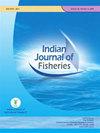来自印度比哈尔邦恒河和Punpun河的池塘倒钩Puntius sophore (Hamilton, 1822)中鱼体与矢状耳石形态计量学的关系
IF 0.3
4区 农林科学
Q4 FISHERIES
引用次数: 0
摘要
本研究估计了经济上和营养上重要的池塘倒钩Puntius sophore的身体和矢状耳石之间的形态计量关系(Hamilton, 1822)。从2021年9月至2022年3月,在印度比哈尔邦的恒河和Punpun河每月采集266份鱼类标本,评估了长度-重量关系(LWRs)、长度频率分布、条件因子和耳石纵横比。鱼长5.57 ~ 11.17 cm,重1.18 ~ 18.98 g。Ganga和Punpun的lws (b>3)的b值分别为3.20和3.17。条件因子表明该物种在两条河流中生长条件最佳。鱼与耳石形态计量学呈正相关,其中鱼总长度与耳石重量的决定系数(R2)最高(R2= 0.942),其次是鱼长与耳石长度(R2=0.90)。所有这些关系对渔业管理具有重要意义,并对未来关于食物摄食习性、种群结构、环境变化和资源保护的时间序列研究有用。关键词:决定系数,条件因子,鱼耳石,生长,长重关系本文章由计算机程序翻译,如有差异,请以英文原文为准。
Relationship between fish body and sagittal otolith morphometrics in the pool barb Puntius sophore (Hamilton, 1822) from the Ganga and Punpun rivers of Bihar, India
The present study estimated the morphometric relationships between body and sagittal otolith of the economically and nutritionally important pool barb Puntius sophore (Hamilton, 1822). A total of 266 fish specimens were collected monthly from the Ganga and Punpun rivers of Bihar, India from September 2021 to March 2022 Length-weight relationships (LWRs), length frequency distribution, condition factor and otolith aspect ratio were assessed. The fish length and weight ranged from 5.57 cm to 11.17 cm and 1.18 g to 18.98 g, respectively. The b value in LWRs (b>3) were estimated as 3.20 and 3.17 for Ganga and Punpun, respectively. Condition factors indicated optimal growth conditions for this species in both the rivers. The fish and otolith morphometrics showed a positive correlation, and the highest coefficient of determination (R2) was observed between total fish length and otolith weight (R2= 0.942) followed by fish length and otolith length (R2=0.90). All of these relationships are significant to fisheries management and useful for future time series studies on food-feeding habits, stock structure, environmental change and resource conservation. Keywords : Coefficient of determination, Condition factor, Fish otolith, Growth, Length-weight relationship
求助全文
通过发布文献求助,成功后即可免费获取论文全文。
去求助
来源期刊

Indian Journal of Fisheries
FISHERIES-
CiteScore
0.90
自引率
20.00%
发文量
0
审稿时长
6-12 weeks
期刊介绍:
Indian Journal of Fisheries is published quarterly by the Indian Council of Agricultural Research (ICAR), New Delhi. Original contributions in the field of Fish and fisheries science are considered for publication in the Journal. The material submitted must be unpublished and not under consideration for publication elsewhere.
Papers based on research which kills or damages any species, regarded as thratened/ endangered by IUCN crieteria or is as such listed in the Red Data Book appropriate to the geographic area concerned, will not be accepted by the Journal, unless the work has clear conservation objectives.
 求助内容:
求助内容: 应助结果提醒方式:
应助结果提醒方式:


